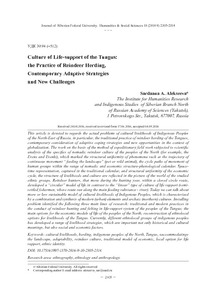Показать сокращенную информацию
Culture of Life-support of the Tungus: the Practice of Reindeer Herding, Contemporary Adaptive Strategies and New Challenges
| Автор | Alekseeva, Sardaana A. | en |
| Автор | Алексеева, С.А. | ru_RU |
| Дата внесения | 2016-10-31T04:16:51Z | |
| Дата, когда ресурс стал доступен | 2016-10-31T04:16:51Z | |
| Дата публикации | 2016-10 | |
| URI (для ссылок/цитирований) | https://elib.sfu-kras.ru/handle/2311/26360 | |
| Аннотация | This article is devoted to regards the actual problems of cultural livelihoods of Indigenous Peoples of the North-East of Russia, in particular, the traditional practice of reindeer herding of the Tongues, contemporary consideration of adaptive coping strategies and new opportunities in the context of globalization. The work on the basis of the method of expeditionary field work subjected to scientific analysis of the specifics of nomadic reindeer culture of the peoples of the North (for example, the Evens and Evenki), which marked the structural uniformity of phenomena such as the trajectory of continuous movement “feeding the landscape” (pet or wild animal), the cycle paths of movement of human groups within the range of nomadic and economic structure-phenological calendar. Space-time representation, captured in the traditional calendar, and structural uniformity of the economic cycle, the structure of livelihoods and culture are reflected in the picture of the world of the studied ethnic groups. Reindeer hunters, that move during the hunting year, within a closed circle route, developed a “circular” model of life in contrast to the “linear” type of culture of life support (semi-settled fishermen, whose route ran along the main feeding substance - river). Today we can talk about more or less sustainable model of cultural livelihoods of Indigenous Peoples, which is characterized by a combination and synthesis of modern (urban) elements and archaic (northern) cultures. Installing problem identified the following three main lines of research: traditional and modern practices in the conduct of reindeer hunting and fishing in life-support system of the peoples of the Tungus; the main options for the economic models of life of the peoples of the North; reconstruction of ethnolocal options for livelihoods of the Tungus. Currently, different ethnolocal groups of indigenous peoples has developed a range of livelihood strategies, which are important not only historical and cultural meanings, but also social and economic factors | en |
| Аннотация | Статья посвящена изучению актуальной проблемы культуры жизнеобеспечения коренных малочисленных народов Северо-Востока России, в частности традиционной практики ведения оленеводства у тунгусов, рассмотрению современных адаптивных стратегий выживания и новых возможностей в условиях глобализации. В работе на основе использования метода экспедиционных полевых работ подвергнута научному анализу специфика кочевой ется структурной однородностью таких явлений, как траектория непрерывного движения «кормящего ландшафта» (домашнего или дикого животного), путей цикличного передвижения человеческих коллективов в пределах ареала кочевания и строения хозяйственно-фенологического календаря. Пространственно-временные представления, запечатленные в традиционном календаре, также структурно однородны хозяйственному циклу, строению культуры жизнеобеспечения и отражены в картине мира изучаемых этносов. Оленеводы-охотники, кочевавшие в течение промыслового года по замкнутому круговому маршруту, выработали «круговую» модель жизнедеятельности в отличие от «линейного» типа культуры жизнеобеспечения (полуоседлые рыболовы, промысловые пути которых тянулись вдоль главной кормящей субстанции – реки). Сегодня можно говорить о более-менее устойчивой модели культуры жизнеобеспечения коренных малочисленных народов Севера, характерной чертой которой является комбинация и синтез элементов современной (урбанизированной) и архаичной (северной) культур. Проблемная установка определила следующие три основные исследовательские линии: традиционные и современные практики ведения оленеводства в охотничье-промысловой системе жизнеобеспечения у тунгусов, основные варианты хозяйственных моделей жизнедеятельности народов Севера и реконструкция этнолокальных вариантов жизнеобеспечения у тунгусов. Выявлено, что в настоящее время в разных этнолокальных группах коренных малочисленных народов Севера сложился целый спектр стратегий жизнеобеспечения, в котором важное значение имеют не только историко-культурные, но и социально-экономические факторы | ru_RU |
| Язык | en | en |
| Издатель | Сибирский федеральный университет. Siberian Federal University. | en |
| Тема | cultural livelihoods | en |
| Тема | herding | en |
| Тема | indigenous peoples of the North | en |
| Тема | Tungus | en |
| Тема | «accommodating» the landscape | en |
| Тема | adaptability | en |
| Тема | reindeer culture | en |
| Тема | traditional model of economic | en |
| Тема | local option for life support | en |
| Тема | ethnic identity | en |
| Тема | культура жизнеобеспечения | ru_RU |
| Тема | оленеводство | ru_RU |
| Тема | малочисленные народы Севера | ru_RU |
| Тема | тунгусы | ru_RU |
| Тема | вмещающий ландшафт | ru_RU |
| Тема | адаптивность | ru_RU |
| Тема | оленеводческая культура | ru_RU |
| Тема | традиционные модели хозяйствования | ru_RU |
| Тема | локальные варианты жизнеобеспечения | ru_RU |
| Тема | этническая идентичность | ru_RU |
| Название | Culture of Life-support of the Tungus: the Practice of Reindeer Herding, Contemporary Adaptive Strategies and New Challenges | en |
| Альтернативное название | Культура жизнеобеспечения тунгусов: практики ведения оленеводства, современные адаптивные стратегии и новые вызовы | ru_RU |
| Тип | Journal Article | |
| Тип | Published Journal Article | |
| Контакты автора | Alekseeva, Sardaana A.: The Institute for Humanities Research and Indigenous Studies of Siberian Branch North of Russian Academy of Sciences (Yakutsk), 1 Petrovskogo Str., Yakutsk, 677007, Russia; E-mail : alexeeva_sar@mail.ru | en |
| Контакты автора | Алексеева, С.А.: Институт гуманитарных исследований и проблем малочисленных народов Севера СО РАН Россия, 677007, Якутск, ул. Петровского, 1 | ru_RU |
| Страницы | 2305-2314 | |
| Журнал | Журнал Сибирского федерального университета. Гуманитарные науки. Journal of Siberian Federal University. Humanities & Social Sciences;2016 9 (10) | en |

